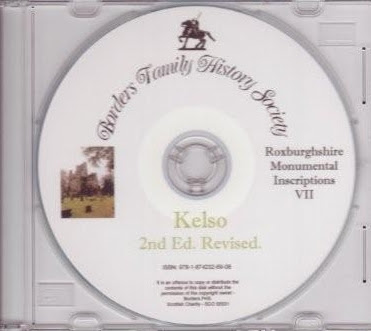The late Audrey Mitchell wrote that Kelso was described by Sir Walter Scott, who attended school there from 1783, as 'the most beautiful, if not the most romantic, village in Scotland'. Early Kelso grew in two distinct halves. Easter Kelso formed in the vicinity of the Abbey, which was founded in 1128 by King David I, and retained its importance as an ecclesiastical burgh until the late 16th Century, by which time the fabric of Kelso Abbey had been largely destroyed and the monks dispersed. Wester Kelso, also known as Faircross, was obliterated in the late 18th Century when the Duke of Roxburgh formed entrance gates to Floors Castle and a fruit garden on the ground occupied by the village. Legend states that plague victims of the 17th century were buried in a mass grave at the Knowes, near the Abbey and bones were found in this area during archaeological excavations. Kelso was primarily a market town and had no large-scale industry until the 20th century.
We've extensively revised and improved this volume (previously known just as Kelso) and it's available on CD.
 |
| Old Kelso volume (superseded) |
It comprises the details and photographs of 460 monumental (gravestone) inscriptions for the Old Churchyard, Purvis Aisle, Kelso Abbey, and St Andrew's Episcopal Church and the inscriptions on 199 stones lost in 1979 when the surrounding wall was removed from the churchyard and new paths were laid allowing direct access from the Knowes car park to the town centre.
We've also included the inscriptions on the Kelso War Memorial, the war memorials in St Andrew's Church, St Mary’s Church, and Kelso High School. It includes a list of ministers, the landowners and tenants on the Hearth Tax assessment in the parish of Kelso in 1690, the men on the Militia list from 1797 to 1801, a plan of Kelso dated 1854.
There is a plan of the churchyard and additionally, there's a list of funerals and dates in Kelso 1798 to 1813. This is particularly useful because many of Kelso's inhabitants were buried without a marker, visitors to the parish were sometimes buried without their name being known. Several regiments were stationed in the town, together with French Prisoners of War and their burials are recorded here, as well as an index to the surnames included in the inscriptions.
There are more than 500 different surnames included in the inscriptions on the gravestones, and they are: Adams, Affleck, Aimer, Aimers, Ainslie, Aitchison, Aitken, Aitkinson, Aldcorn, Alexander, Allan, Amey, Anderson, Andrew, Archbald, Armstrong, Arniel, Arnold, Auchterlonie, Awburn, Bailey, Baird, Balfour, Ballantyne, Balmer, Baptie, Barclay, Barker, Barstow, Bell, Bennet, Best, Bettie, Biggar, Bishop, Biss, Black, Blackhall, Blackie, Blair, Blaw, Blenkinsop, Blyth, Blythe, Boazman, Bolton, Bonar, Bonthorn, Boole, Borthwick, Boston, Boswell, Bothwick, Bowie, Bowman, Boyd, Broad, Bromfield, Brooks, Broomfield, Brotherston, Brown, Brownlee, Brownlees, Bruce, Brunlees, Buchan, Buchell, Buckham, Buddo, Bulman, Burn, Burnet, Burnett, Burns, Burrows, Cairns, Carfrae, Carss, Cassy, Chalmers, Charlewood, Chisholm, Clark, Cochrane, Cockburn, Cook, Cooper, Cossar, Craig, Cranston, Cranstone, Craw, Crawford, Crease, Crichton, Crosbie, Culbertson, Cunningham, Cunninghame, Curle, Curle, Curle, Curll, Curry, Dakin, Dalgleish, Dames, Darling, Davidson, Dawson, De Borgh, Deans, Dennistoun, Dewar, Dickie, Dickinson, Dickman, Dickson, Died, Dippie, Dixon, Dobson, Dodds, Dods, Douglas, Dryden, Drysdal, Drysdale, Dudgeon, Duke, Duncan, Dunlop, Dunn, Dunnings, Dunsmure, Easton, Edmonston, Elliot, Emen, Ewen, Fair, Fairbairn, Falconar, Falconer, Falkner, Fawcit, Fender, Ferguson, Fergusson, Ferne, Fettes, Finch, Fishburn, Fleming, Fletcher, Flighty, Flintoff, Foord, Forbes, Ford, Forrest, Forrett, Forsyth, Frank, Fraser, Frazer, Frier, Fullerton, Fyfe, Gallon, Gaston, Gibb, Gibson, Giles, Gillespie, Gillies, Glaister, Glass, Glendining, Glindinning, Gordon, Gosset, Gow, Graham, Gray, Greenlaw, Grey, Grieve, Grossert, Guthrie, Haig, Haldane, Hall, Halliburton, Hambley, Hambly, Hammond, Happer, Hardie, Hay, Hedley, Henderside, Henderson, Henry, Herbert, Hermiston, Hervey, Hewat, Heweit, Hewitson, Hill, Hillson, Hilson, Hindle, Hindmarsh, Hislop, Hislope, Hogarth, Hogg, Holman, Holme, Holmes, Home, Honeyman, Hood, Hookes, Hooper, Hough, Howlistone, Huggan, Huie, Humble, Hume, Hunter, Hush, Hutchinson, Hymers, Imieison, Innes, Innes Ker, Irvine, Jack, Jackson, Jaffrey, Jameson, Jamieson, Janitson, Jarvie, Jeffrey, Johnson, Johnston, Karr, Kay, Keenan, Keith, Kell, Kennedy, Ker, Kerr, Kerss, Kinghorn, Knox, Kydd, Kyle, Ladlin, Laidlaw, Lamb, Lamont, Lauder, Law, Lawlee, Lawson, Lawton, Leadbetter, Learmont, Learmonth, Learmouth, Leck, Lee, Leech, Leitch, Leyden, Liddell, Lidgate, Lillie, Limmon, Lindores, Lindsay, Linton, Litster, Loasby, Lockie, Logan, Lorimer, Lundie, Lunn., Lyell, Lyle, Lynn, Mcallister, M’cheyne, Mccoln, Mccorquodale, Mccutcheon, Macdonald, Mcdougal, Mackdougall, Mcdougall, Macintosh, Mackintosh, Mcintosh, Mckay, Mackenzie, Mckenzie, Mckinlaw, Mckraket, Maclean, Mcleod, Mabon, Main, Manl, Marjoribanks, Marr, Marsh, Marshall, Marten, Mason, Mathew, Mauchlen, Maule, Maxwell, Meather, Mein, Melrose, Menin, Merrylees, Michie, Mickle, Middlemas, Middlemiss, Middlemist, Millan, Millar, Miller, Mills, Milne, Mitchell, Mitchelson, Moffat, Moir, Mollifof, Moore, Morison, Morrison, Morton, Moscrip, Moubray, Muir, Munro, Murdy, Murray, Needham, Neil, Nelson, Nesbit, Newton, Nicholson, Nicol, Ogden, Oliphant, Oliver, Ord, Ormiston, Ormston, Oswald, Ovens, Paton, Patterson, Pattison, Paul, Pearson, Peat, Penman, Perfect, Pettigrew, Pillans, Pirie, Pitcairn, Pittillo, Plummer, Porteous, Potts, Primrose, Pringle, Proctor, Purves, Purvis, Pyle, Rae, Ramsay, Ranton, Rathie, Rea, Redden, Redpath, Reid, Renton, Renwick, Richardson, Richmond, Rickets, Riddel, Riddell, Ridley, Ridpath, Rintoul, Ritchie, Robertson, Robinson, Robison, Robson, Rogerson, Rolph, Romanes, Romanis, Ronald, Ross, Routledge, Roxburgh, Rule, Russell, Rutherford, Rutherfurd, Ryrie, Sadler, Sanderson, Scott, Sear, Selkirk, Sharp, Shaw, Sheil, Shiel, Shiell, Shirreff, Short, Simpson, Sitwell, Slight, Small, Smith, Somerville, Spark, Spiden, Spottiswoode, Stalker, Steel, Stenhouse, Stephenson, Stevens, Stevenson, Stewart, Stimpson, Stobo, Stodart, Stoddart, Stormonth, Story, Strachan-Audas, Stuart, Sudden, Swan, Swanston, Swinton, Sword, Tait, Tasker, Taylor, Telfer, Telfor, Thompson, Thomson, Thorburn, Tinlin, Tod, Torrie, Train, Tranent, Trotter, Tully, Turnbull, Turner, Tyrode, Valance, Waddle, Waldie, Waleid, Walker, Wallace, Wardlaw, Watson, Watt, Watters, Waugh, Weatherston, Weddell, Weir, Welsh, Wemyss, White, Whitecross, Whitehead, Whitelaw, Whitelock, Whitlock, Whyte, Wight, Wightman, Wild, William, Williamson, Willink, Wilmot, Wilson, Winter, Wood, Woodrow, Wright, Wylie, Young, Yule.
Search the
Gravestones Index in the usual way, to see how many stones there are for a surname.
The CD costs £10 plus postage.
To get a copy, please contact Mary Thomson on our
Contacts page using the contact type Order for Publications.













